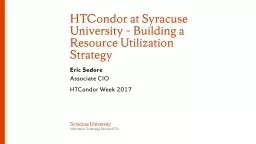

Eric Sedore Associate CIO HTCondor Week 2017 Good to advance research best to transform research though transformation is not always related to scale Entrepreneurial approach to collaboration and ideas ID: 778441
Download The PPT/PDF document "HTCondor at Syracuse University – Bui..." is the property of its rightful owner. Permission is granted to download and print the materials on this web site for personal, non-commercial use only, and to display it on your personal computer provided you do not modify the materials and that you retain all copyright notices contained in the materials. By downloading content from our website, you accept the terms of this agreement.
Slide1
HTCondor
at Syracuse University – Building a Resource Utilization Strategy
Eric Sedore
Associate CIO
HTCondor
Week 2017
Slide2Good to advance research, best to transform research (though transformation is not always related to scale)
Entrepreneurial approach to collaboration and ideas
Computing resources are only one part of supporting researchStrive to use computational resources at 100% utilization, 100% of the timeComputational resources must support multiple academic areas
Research Computing Philosophy @ Syracuse
Slide3Academic Virtual Hosting Environment (AVHE)
– private cloud1000 cores, 25TB of memory
Individual VMs (students, faculty, staff), small clusters2 PB of storage (NFS, SMB, DAS per VM), multiple performance tiersOrangeGrid
–
high throughput computing pool
scavenged desktop grid, 13,000 cores, 17TB of memory
Crush
– compute focused cloudCoupled with the AVHE to provide HPC and HTC environmentsMade up of heterogeneous hardware, different areas within Crush are focused on different needs (high IO, latency/bandwidth, high memory requirements…)12,000 cores (24,000 slots with HT), 50 TB of memorySUrge – GPU focused compute cloud240 commodity NVidia GPUsIndividual VMs / nodes scheduled via HTCondor
Computational Resources @ Syracuse
Slide4Resource deployment
Virtualize everything – systems for building nodes, no affiliation, everything loosely coupled
(i.e. researchers never touch bare metal)
Tools for deploying and managing 10,000+ VM’s in 4 virtual environments
(KVM, Hyper-V, vSphere,
VirtualBox
)
“Virtual Clusters” network, data, scheduling
Researchers can utilize existing “standard” environments or build a unique environment
Slide5Allocation of resources
Syracuse Researchers
Open Science Grid (OSG)
H
ybrid and Opportunistic
Public Science
(E@H...)
Slide6Slide7What resources should Syracuse provide?
“Small scale” research – accomplished on desktops/laptops
1-4 cores, 1-16GB of memory, GB’s of data
“Small / Medium scale” research – accomplished in the cloud
1-200 cores, 1GB-2TB of memory, TB’s of data
Individual virtual machines to small clusters
“Medium scale” research – accomplished in clusters
1000’s of cores, 10’s of TB’s of memory, TB’s of data
Provided by SyracuseUtilization at 85+% (from an IT Perspective)“Large scale / Specialized” research – accomplished in national infrastructure10,000+ cores, 100’s of TB’s of memory, PB’s of dataProvided by National ResourcesNot enough need (today)to invest at this level
Slide8Core Elements
HTCondor
Primary tool for resource scheduling – everything (almost) else is a pain!
Node advertising capabilities
Simplicity of addition/removal of nodes (part its scavenging roots)
Flexibility – small simple environments to larger more complicated environments
Virtualization (KVM, Hyper-V, vSphere,
VirtualBox
)Abstraction – shim allows us to easily reallocation resources, including networking and storageFlexibility – easy to run multiple kinds of workload (Windows/Linux)In-house coding / scripting – primarily in management / deployment – interacting with hypervisors
Slide9Pain Points
VM
Management – we have ~20 VM environments within Crush alone
Versioning, automation, best of breed VM / monolith VM
What
do we need? Singularity / Docker When do we need it? Now
!
Staff Expertise
Complexity, staff resources, single person dependencies - systems focused on being operated by a fraction of a staff memberNuance/elegance is lost, often the “right way” is set aside in the necessity to move on to the next
Slide10Law of unintended consequences is alive and well – changes always have impact
There is a knob for everything…
Logging is spectacular, deep, voluminous - “a blessing and a curse” You can have multiple versions of HTCondor components in your environment, but anecdotally you will occasionally find “odd” interactions
Musings on Our
HTCondor
Experience